April/May 2018
Autumn Leaves, or…
There is Bothing Netter than Movember in Nay!
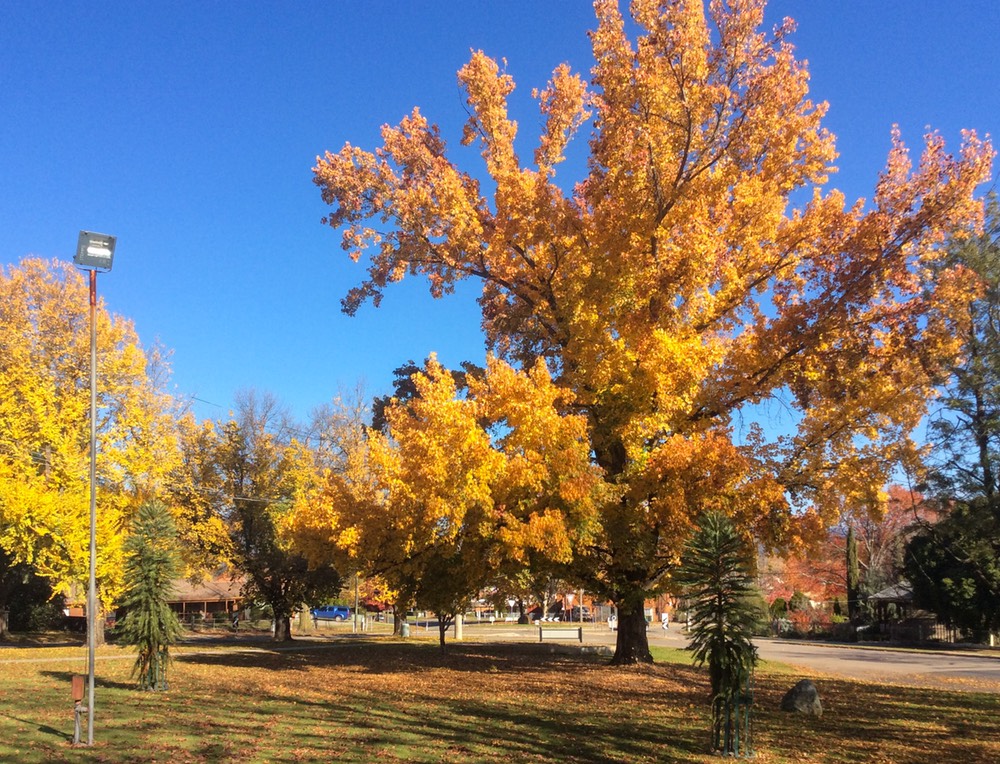
Suddenly! Good grief! It was time to get ready to leave Australia. Even we understand that eventually all journeys must come to an end. When we left Tasmania at the end of March, we were already thinking — we’ve got two months left; what do we most want to see and do while we’re still here? And it was Spring… no, Fall. After a full year in the southern hemisphere we are still easily confused on these important issues. It was definitely getting cooler and the days were getting shorter, but it was April.
Anyway, two months is plenty of time, but then again not so much. And everybody says the same thing: as soon as your ending date starts looming out there (our visas would expire on the 9th of June), the mind shifts from what do we want to do today, to what should we do today because we’re running out of time.
So we started a list (Kathy really likes lists). The historic car races, near Adelaide, in South Australia, were beckoning; also a trip to Canberra (Can-bra, they say here) to see the sights in the Capital. And we really wanted to spend more time back in the high country; and oh there was an interesting sounding Aerodrome and museum in Temora, NSW; and near Temora was Junee, home of, now wait for it… The Junee Organic Licorice and Chocolate Factory!
Okay! That made a good start; and we’d see what else developed. The fact that Adelaide and Canberra are 1,200 kilometers apart and each one about 700 kms from Melbourne was not lost on us. But we knew the distances would give us excuses to explore more out of the way places as we traveled. Besides, at this point, in early April, we hadn’t a clue as to just when we would be shipping the Tiger off to its Next Exploration Entry Point. NEEP? Why not?
But first — “There is Bothing Netter??” What in Sam Hill does that mean? With full credit to the Washington DC comedy troupe, “The Capitol Steps”, that’s a paraphrase of one of their terrific comedy routines going back to the early ’90’s. NPR fans will understand.
So to finally begin our tale. We got off the Tassie ferry, back in Melbourne, late evening on March 30, and drove straight up to the home of some really nice folks we’d met last July at Devil’s Marbles in the Northern Territory. Ken and Judy showed us a great time. They live in the rural northern suburbs of Melbourne, out where land goes with the property; there are birds in the many trees, friends have wild kangaroos cruising through their yard, and you can go hiking along river beds and poke around in holes made by wombats. It was pretty super. We met some of their friends and offspring, ate and drank well, and learned why they had chosen to live here.
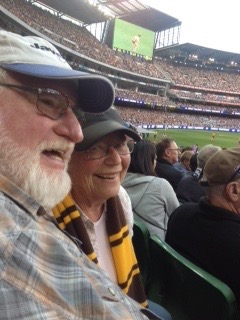
And then, then, we were taken to see the “footy” - WOW!!! Go Hawks! It was really cool. The Geelong Cats were in town to play our newly beloved Hawthorn Hawks — at the Melbourne Cricket Ground (the MCG or “the G” to those in the know) — and such excitement! The MCG hosted its first contest in 1858, was home to the Olympic Games in 1956, is in near constant use for a variety of sporting events, and is just plain super. We had a marvelous time! With Ken whispering the intricacies of Aussie Rules Football, we were yelling and shouting and cringing when something went wrong for our team. Despite leading much of the way, it was looking pretty dismal for the home side until almost the end; then, by some arcane maneuvers we’ll never understand, the Hawks suddenly emerged victorious, sweeping to a dramatic one-point victory. Such a noise erupted!!! Such cheering on the train heading back; really a great afternoon and a wonderful and unexpected experience. Thanks, guys.
Finally tearing ourselves away, we drifted down to a spot southeast of Melbourne to visit some other friends, Ron and Viv Moon, great explorers whom we’d first met at an Overland Expo in Arizona a few years earlier. The Moons are highly regarded in the overlanding field in both Australia and Africa, leading trips and writing books and sharing their mountains of experiences with all they encounter. They welcomed us into their home, and offered us a place to return to and a yard to park in while we went through all the preparations for shipping the Tiger when the time came.
We could have hung out longer with the Moons (and other overlanders also in town), but we needed to get moving. Before heading west toward the car races we still wanted to head back up into the Alps, some of the loveliest area of Australia’s Great Dividing Range. Back in January, before heading off to Tasmania, we’d spent a fair amount of time up in the mountains, particularly in the Alpine and Snowy River NPs. These are really special places, with high mountains, lovely rivers and trees, pretty meadows, and plenty of wild animals to enjoy.
And now we were going back so we could pick up where we’d left off. Heading out of the greater Melbourne area we stopped first at the great little country town of Maffra for a couple of days, checking out the Gippsland Motor Museum and other local historic structures. Nice area, with lots of colonial architecture.
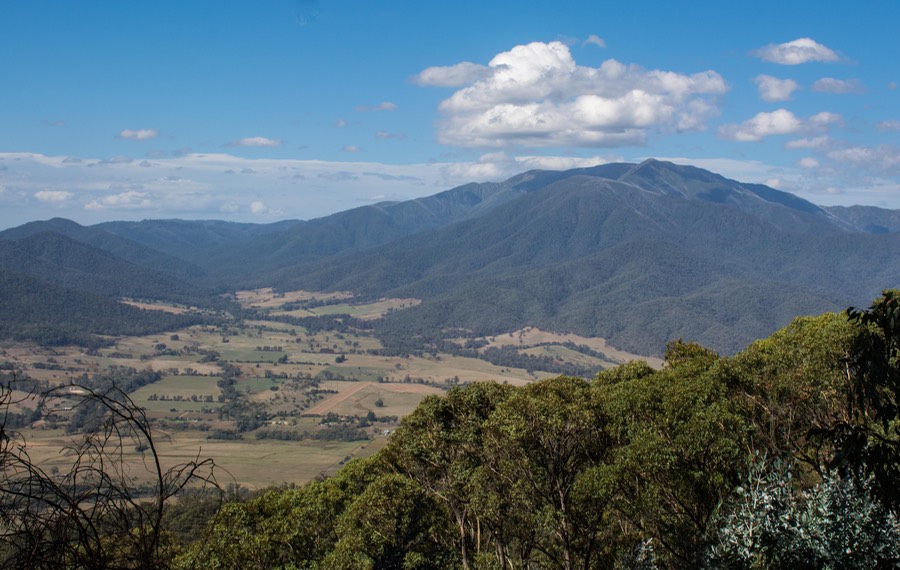
Then on up into the mountains we went, on our way back up to Bright. You remember Bright, don’t you? That’s where Rick took a tumble and looked like he’d lost his match-up with a kangaroo. You’ll be quite pleased to know that he’s returned to normal, and his scar is only apparent to those who know where to look — not as dramatic as he’d hoped, but it still made a good story. Anyway, that episode had interrupted our plans in the area so we wanted very much to go back and pick up where we’d left off.
In the foothills, the trees are starting to turn, and it’s very, very dry; we started the day in Maffra in the upper 80’s (30˚C), with very high winds. As we got to higher elevations, it was a bit cooler and the poplars were stunningly yellow. Twenty kilometers north of Dargo we were back onto gravel — this is the Dargo High Plains Road — great name, and very nice, if terribly dusty right now. We hit 1635 meters as we crossed the open plain, and the temp had now cooled down to 64 degrees. We were back in a section of the Alpine National Park.
By night we’d settled in near Bright, somewhere along the river; the next day we climbed up over the Tawonga Gap Road to Tawonga, then on to Mitta Mitta, with Mt Bogong on our right; a lovely drive, following the Mitta Mitta River part of the time. This is incredible country, possibly the best of Victoria. And in the early autumn — spectacular.
Oh, bother; we had a new rattle Rick was trying to identify. Eventually, we found ourselves traveling down a rough mountain road, with Kathy steering from the passenger seat while Rick hung his head out the driver’s window, trying to locate the rattle. A possible identification was the best we could manage, but we started thinking about where to try and get it fixed before leaving the country.
That same night we woke to very heavy rains and discovered one of the small windows we both thought was closed tight had been left wide open — water was everywhere and the mattress and sheets were completely soaked through. We quickly closed the window and shifted around a bit so we could get back to sleep. In the morning, we pulled the bed apart and hung said mattress off the over-cab platform down into the area between cab and house; we spent the day ducking under it, moving it about, and generally trying to get some dry warmth to help us out. Eventually the mattress de-sogged and we were able to make the bed up again. Such a mess!
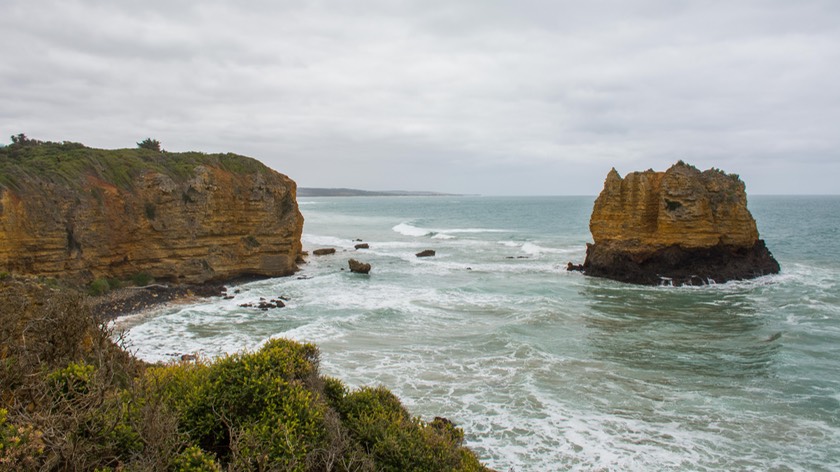
By now it was mid-April, and time to start heading west if we were going to get to the historic car races near Adelaide. Now, if you know Australia, you realize that Adelaide and Melbourne are a fur piece apart, although not bad if you take the main highway (8 hours, someone said). But ha! We had no intention of doing such a thing. We had the time (and some inclination) to take a scenic drive, The Great Ocean Road, that runs along the southern coast all the way to the South Australia state border. Hey, why not?
Why not? For a couple of good reasons, which we will get to in a minute. But it’s a very popular “must-do” drive, going along a lovely coastline. We’re a little shy of anything labeled “must-do”, but we didn’t want to be fools and just skip something on principle, so off we went. As it turns out we should have settled for “foolish.” There was a tremendous amount of road work underway along the road, which was jammed with sightseers, we realized that a fair amount of road isn’t even along the coast at all, and it actually looks a whole lot like driving the Pacific Coast Highway in California (Highway One) — although there is a very pretty waterfall thrown in to sweeten the trip.
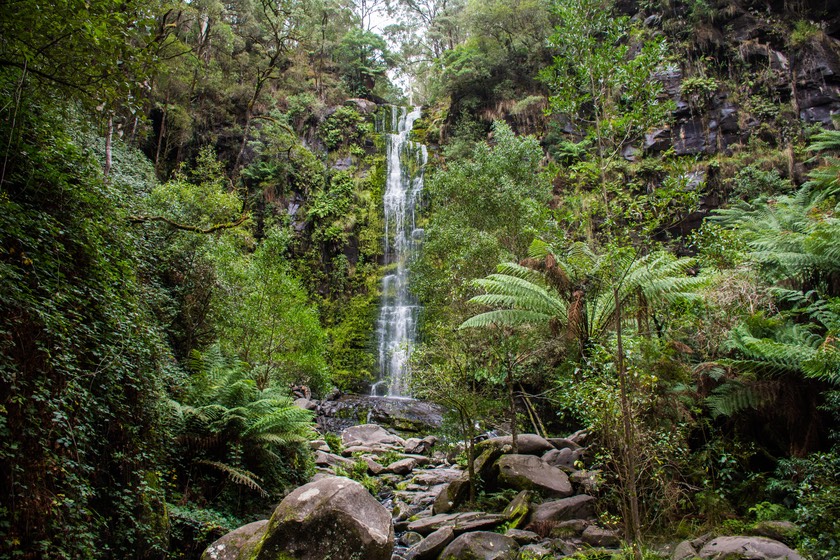
After a few hours we decided we’d had enough, and went inland along a pleasant forest road, back up over the coastal hills, and entered very nice farmland. We found a pretty lake with lots of birds where we could stay the night, reminding ourselves once again how much we prefer inland areas to coastlines.
Not wanting to totally give up on the GOR, we ducked down to the coast once more at Warrnambool, where there was a cheese factory that showed promise. We drove through fields edged with old stone walls and filled with dairy cattle; it was quite nice and reminded us once again of the Oregon coast around Tillamook. The Cheese Factory in Allansford provided us with excellent milkshakes and some nice cheese; then we were off inland again and heading toward the South Australia border.
We stopped for the night in Casterton, one of our favorites and the home of the Kelpie work dogs. We’d been here over New Years, and it’s a town we really enjoy. You park along a bend in the river, the locals come by to chat, and the horse in the nearby field keeps a close eye on your apple supply. We could make a good home in Casterton.
The next day we crossed the state line, stopped in Penola for morning coffee with friends who live nearby, and headed up into the interior, aiming for the Mallala Motorsport Park north of Adelaide — the car races where our friends Michael & Norma Henderson would be in attendance. This is historic sports car racing and Michael has been active in it for many years. He was in fact the oldest competitor present for this meeting at 81, although a few of his best friends are not that far behind him. It was a lovely weekend with excellent weather and a nice mix of old cars; a fine time was had by all.
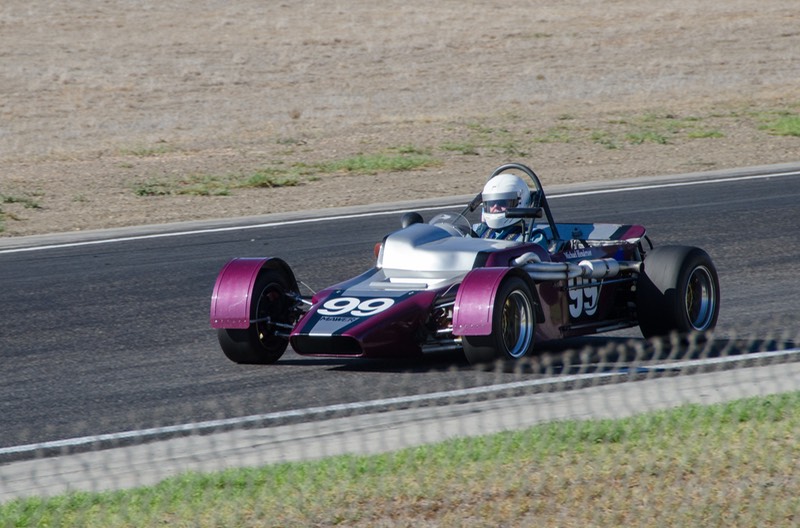
Saying goodby to our friends for the last time this trip, we struck out for new adventures, gently moving north and east through the wheat fields, all cleared by now, heading toward Peterborough (SA) and then to the infamous town of Broken Hill, just across the border into New South Wales. We’d seen some of this country 10 months ago, heading for the Flinders Ranges and then on to Alice Springs.
Broken Hill is best known to us as the setting for the bar scene in Priscilla (that’s the terrific film, The Adventures of Priscilla, Queen of the Desert) where Bernadette out-drinks the local female toughie. Great town, great scene, great movie. Our favorite Australian film of all time.
Anyhow. We spent a couple of days wandering Broken Hill and environs. This is rough mining country and not much to look at. It’s scrub desert, with lots of emus and kangaroos and tons of wild goats. And you can add a strange time zone arrangement to the mix. It seems Broken Hill is much more closely aligned with its SA neighbors than with the NSW folks further east. It has decided to stay on SA time (one-half hour earlier than NSW); cannot blame them, but it seems to muggle up the tourists something fierce. Not us old-timers, of course, who long ago learned that time changes are more easily handled when you don’t wear a watch.
Leaving old BH (which actually has a fair amount of charm), we headed out further into the desert, taking a route that would put us on dirt and gravel for the next several days. As we wandered, we thought about the history of this area. Australians are justifiably proud of their heritage and the development of a largely inhospitable land. We mostly see dirt and cope with flies, but we’re on the wrong end of it of course. Very brave men (and women) headed into the interior, with the hope of finding water often enough to keep them alive. This is Sturt country. Charles Sturt (yup, it’s Sturt, not Stuart, although there’s one of those too in explorer history around here) crossed through here heading further towards the interior, hoping to find the inland sea he expected was somewhere in the middle of the country. A brave man indeed, though mistaken about the inland sea.
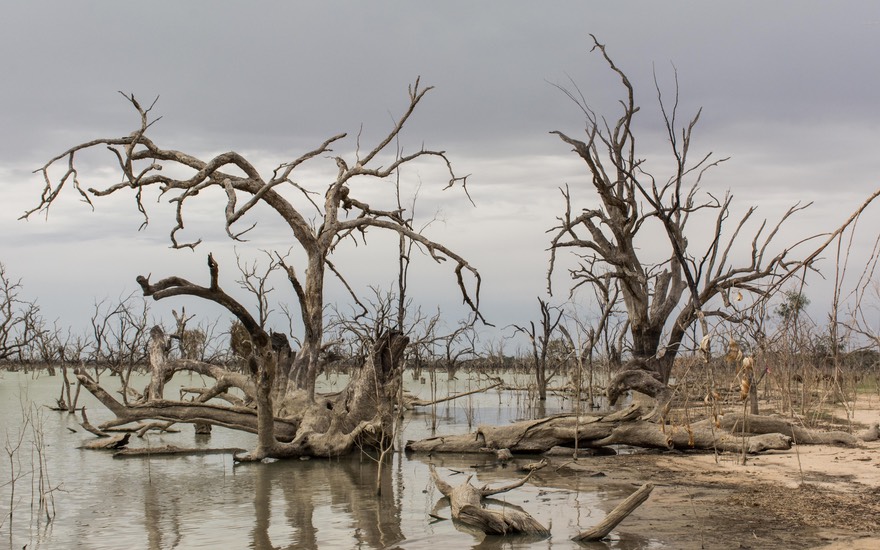
The area around Broken Hill may be inhospitable, dry and dusty, but it contains several interesting national parks, all of them with an indigenous element. In the interest of time and efficiency, we settled on two to visit. The first was Kinchega NP, encompassing a riverine system, a series of flood plains fed by the Darling River. The Paakantji Aboriginal people have lived in this area for many generations.
We spent a delightful night along the sandy shores of Lake Pamamaroo, which is shrinking in the late dry season. As the waters recede, the drowned trees emerge, with naked limbs all ahoo. It’s quite dramatic, and the addition of emus foraging along the shore added considerably to the mood.
The next day we followed the bends of the Darling, on a road lined with beautiful red river gums, to the really interesting Kinchega Woolshed, established in 1850. This was a really cool place; we spent a lot of time poking around and learning how the shearing business was carried on back in time and how drought and over-stocking nearly put an end to it in the 1880s. It was surprisingly engrossing, with excellent information panels and the restored and well maintained original woolshed open for exploration.
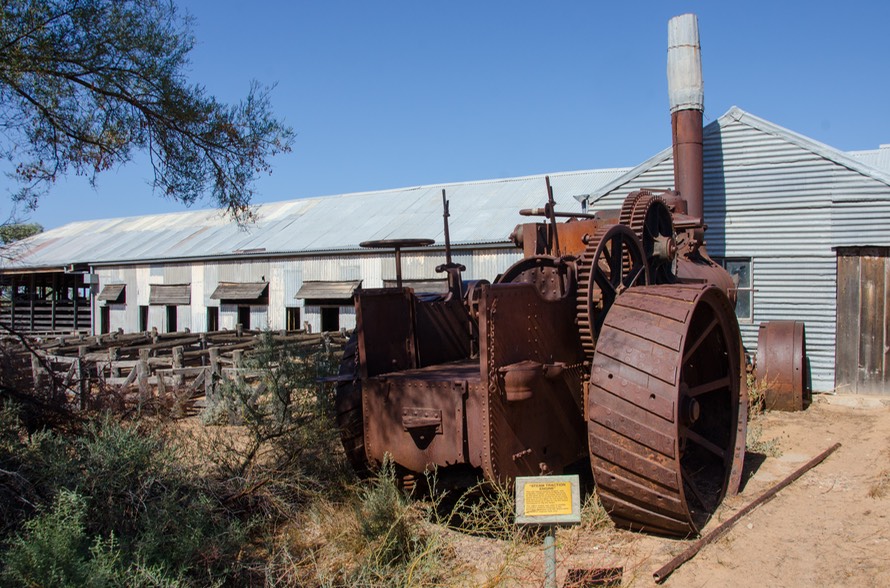
We spent the night in the hamlet of Pooncarie, along the river, where we heard a kookaburra for the first time in many days. He’s a favorite, so we welcomed him back.
Still on the edges of a great grey desert, we continued on to Mungo National Park, in a world heritage area. This is a park managed jointly by the NSW government and the local Aboriginal peoples. The visitors center here is excellent, with really good information and a super focus on what’s actually important (no key chains for sale). Historically, it was home to a huge wool operation, and the woolshed here gave us a chance to compare this site with the one we’d seen earlier at Kinchega. At both places there was a lot to learn.
Mungo NP is an extremely important indigenous site; there is evidence here (including actual human footprints preserved in the clay) of continuous human activity for more than 50,000 years. Imagine that. The footprints have been preserved and have now been covered with protective soil; they cannot be seen. So the tribes have created an open space where reproductions of these footprints have been set into the earth in the same patterns, and you can walk among them. It’s very special.
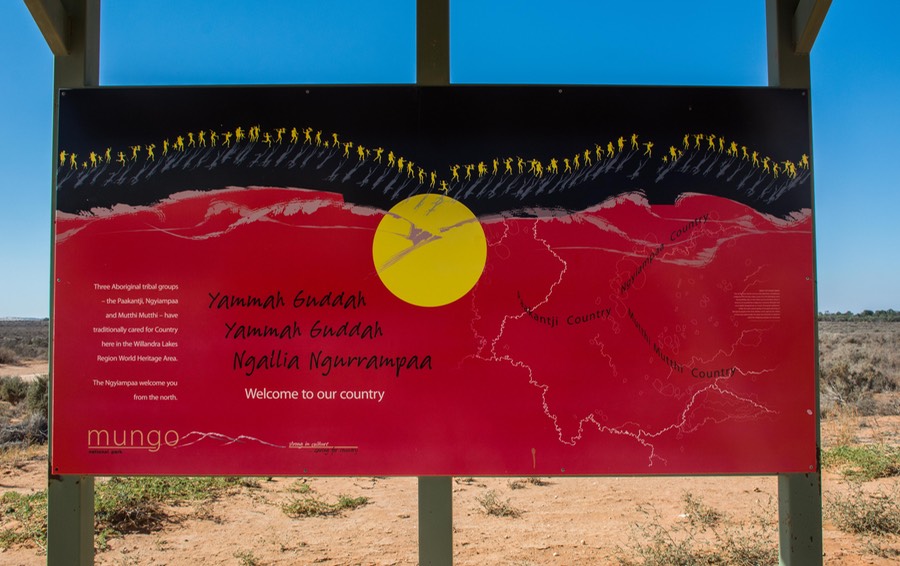
They had some wonderful graphic displays at the visitor center here at Mungo. The best one, we thought, was this long line of human shapes of varying sizes and postures stretching all the way across a large panel. The text indicated that each of the figures represented ten generations of indigenous people living in this area, which meant that there were about 200 figures in the line, and this seemed about right. What the panel did not say, but left for us to figure out for ourselves, was that it was only after 199 of these figures, representing among them nearly 2,000 generations of human endeavor in the area, did the first white European settlers arrive here — less than 200 years ago. We were blown away.
On the same site is a wall of earth that has been formed over the millennia into a lunette. A lunette is a wind-created wall that has grown up at the end of one of the dry lake beds, with interesting and strange sand formations and deposits of various elements from the lake bed. It’s rather famous, but probably much more dramatic at sunset.
Probably we should have stayed. But we both felt it was time to move on, out further into the desert. We tooled along, enjoying pretty good (though very dusty) road most of the time, with emus, galahs, kangaroos (Western greys), termite mounds, magpies and goats for company. Our eyes were focused on the tiny one-horse town of Ivanhoe, population 300, a bit of a distance ahead. Our GPS said there was water and fuel, a caravan park, a post office, and a grocery. And yup, they were all there. All packed into the one single building (the nearby grocery store had closed, but the fuel station was filling in the gap pretty well). So much for urbanization!
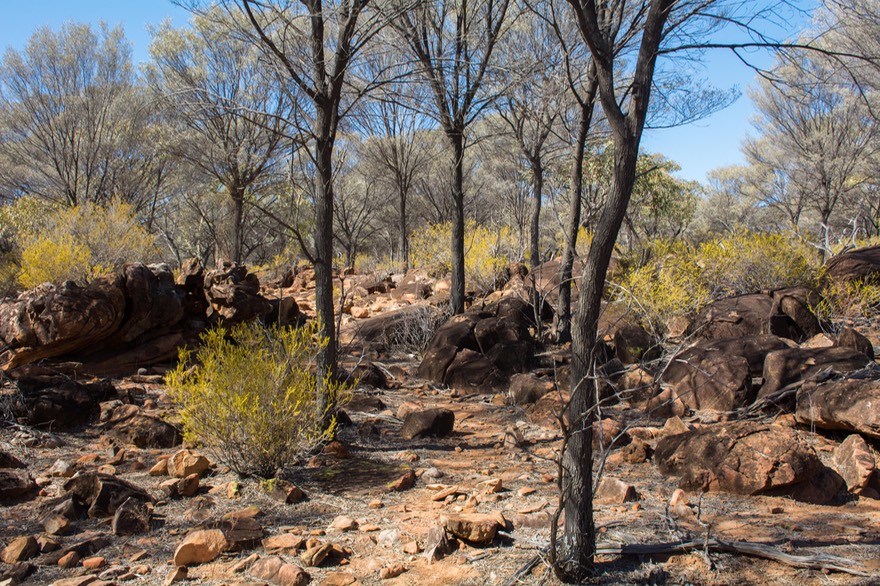
So Ivanhoe didn’t hold us for long; just fuel and ice cream bars if memory serves. Back out into the desert, where we finished up our 513 kms of dusty dirt and gravel as we crossed onto Highway 32, a mere 63 kms west of the small mining town of Cobar. Did I say dusty enough times?
Cobar was going to be our filling-up, laundry, tourist office, green grass town. But before driving there, we had one significant stop to make, at Mount Grenfell Reserve, which was the reason for taking the route we’d chosen. At this location out in the desert, there existed an important Aboriginal rock art site, so Kathy took off to explore. The site was part of the Ngiyampaa Walkabout, a several-kilometer explore of this desert that had many information plaques and ended up at the art site. Two hours later she emerged, whupped but mighty pleased she’d made the whole journey. “Really cool paintings”, she says. Rick made lunch.
The reality of Cobar is that it’s not all that much, but it is an oasis in the desert and the biggest thing around, so we hung out a bit, taking care of a few things and replenishing supplies. It was nice to see green. It was windy and dusty. While doing laundry, a lady nearby commented that they’d had a total of 9 mm of rain this year — that’s about 3/8”, i.e., not much — the lakes are all dried up, but the mining is still going strong. She’s worried about the men working in the mines; all that dry dust is hard on their lungs.
We’re now in what’s referred to as Central New South Wales. We stopped in Warren, the regional center for a big cotton-growing area on the Macquarie River, then the next day followed a winding road along the river, through Gin Gin to Dubbo for lunch and then through the rolling hills to Bathurst — Australia’s first inland city and begun in 1815. Known to the locals as Bath-ust; they’ve gone and lost the R once again.
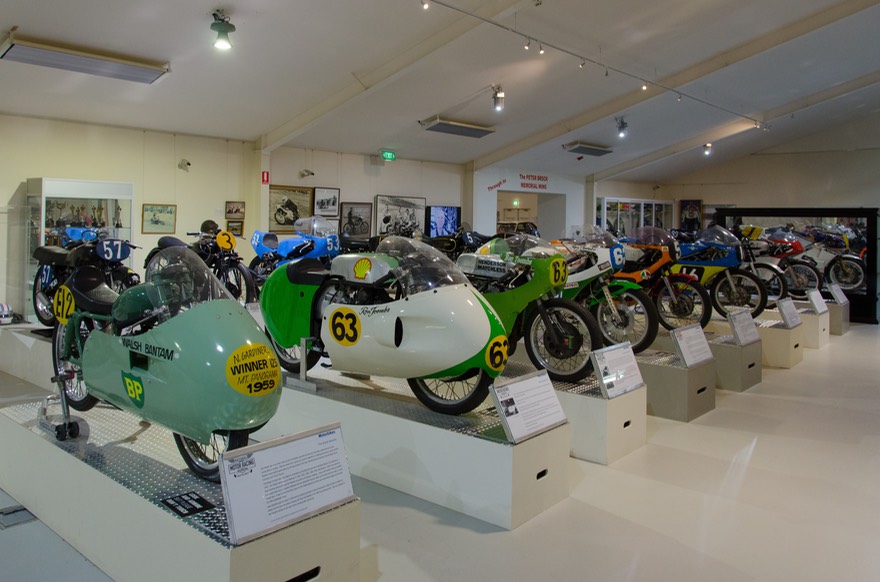
So; why Bath-ust. Well, it’s the home of the Mount Panorama Racing Circuit and the National Motor Racing Museum. So there. Go forth and enjoy. Rick spent an hour or so in the museum, which he describes as OK but a bit disappointing. The thing is, Australia had its own auto industry for decades and it has only recently shut down; as in 2016 recently. Holden, Ford and Chrysler all had big factories. So, quite naturally, the car museums in Australia tend to focus primarily on Australian cars, drivers, racing history, etc. Not a thing wrong with any of that, but they tend to be less interesting to outsiders.
The museum did have a nice selection of motorcycles on hand and these were far more interesting to our intrepid correspondent. Pride of place in this group goes without question to Wayne Gardner’s 1987 500cc World Championship Rothman’s Honda NSR. This machine was on long term loan from Wayne, who was Australia’s first motorcycle world champion. You’ll find a write up of our visit and a link to our photos of the museum on the Australia & New Zealand page of our companion website Motor-Museums.com.
We moved on through the pleasant fall countryside, heading for the very, very interesting town of Cowra, which had been recommended by friends. We thank you again, Betsy and John, for mentioning it. Cowra is a really special town and near as we can tell they’ve kept the R.
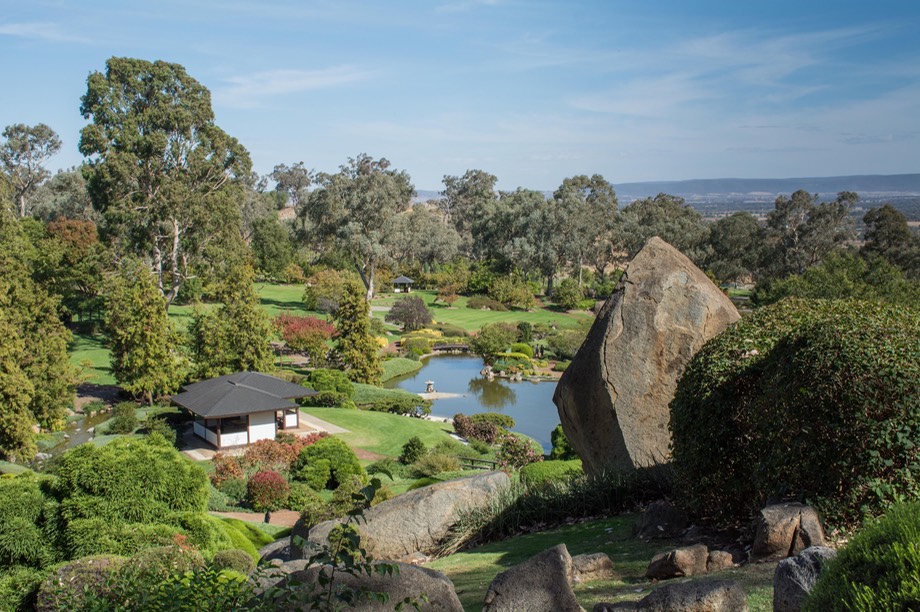
During World War II, a prisoner of war camp was developed in the nearby countryside, and it housed prisoners from several different enemy countries. There was an Italian contingent and some other Europeans, but most significant to our story were the Japanese prisoners. At one point, a number prisoners escaped; they were eventually captured, but losses were significant on both sides. Since the war, there has been a huge bond that has grown up between the Japanese and the Australians, and the actions of the citizens of Cowra were a big part of the reason. There is a lovely, huge World Peace Bell; a Japanese garden; POW cemeteries, ruins of the POW camp; and other sites that can be visited. The Japanese garden was particularly lovely, aided by the fact that it contained a thousand pine trees. The trees had been donated by Sugao School in Japan over a period of four years, and each year students from the school came to Cowra to help with the planting of the trees. A very interesting display in the visitor’s center has a hologram talking about the effect of the camp on the townspeople. It’s all very well done and anyone who comes to this area should spend a day here.
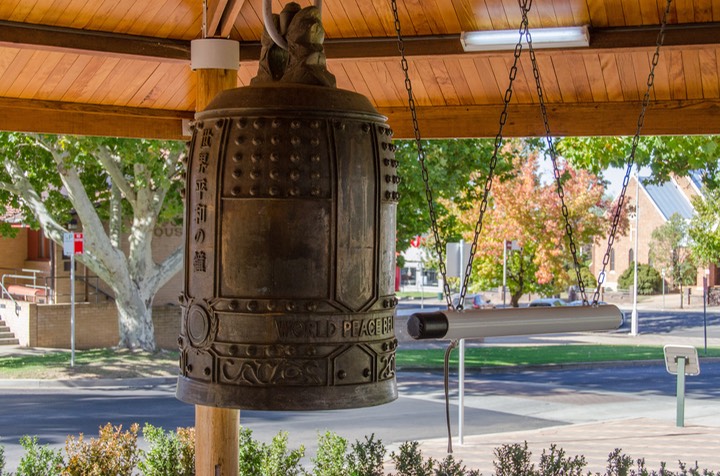
Back to the World Peace Bell, we found this especially moving and impressive. The World Peace Bell Association is operated by the United Nations and cities must apply for authorization in order to get a bell. The one in Cowra was established in 1992 and was Australia’s only bell until earlier this year when Canberra was awarded one as well. This town of about 10,000 folks had it, not Sydney or Melbourne or Brisbane. It was placed here in honor of Cowra’s long history of activity in fostering the concept of world peace. This is indeed a pretty special country town and it has been for quite some time.
From Cowra we headed on toward Canberra. We wanted to see several of the museums there, and had made plans for that. We visited at the weekend in order to make traffic and parking easier and stayed at a showgrounds campground near the center of the city. Over a period of three days we drove in and saw four different, very interesting museums. Canberra is a nice city for a national capital, very clean and neat; some have even said it’s a bit sterile. But we enjoyed ourselves.
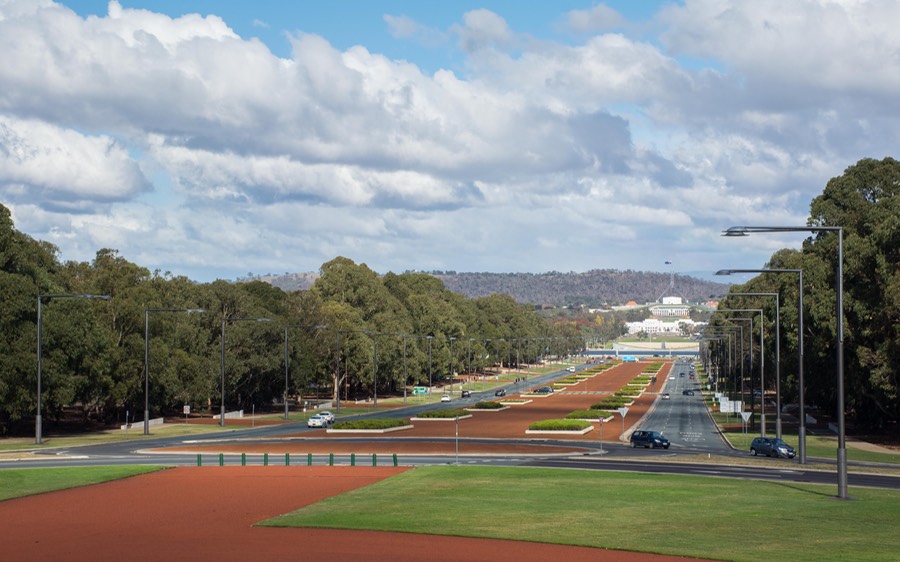
The museums were all very good and each of them could have justified a longer visit than our tired feet could provide. We started at the Australian War Memorial and possibly enjoyed it the most, with its extremely good displays and exhibits and films. We also went to two galleries, one the National Gallery of Australia and the other the National Portrait Gallery. They are located right next to each other, which simplified parking arrangements, and both are excellent.
The National Gallery is a fascinating place with a large and wonderful collection of Aboriginal art. There were some extremely powerful pieces here describing life as an aboriginal person in white Australia. Please be sure to go to our Photo Page to enjoy our pictures of the Gallery and of each of these excellent museums. We’d been introduced to the Portrait Gallery when we visited a traveling exhibition from there in Devonport, Tasmania. It was also a terrific gallery with both painted and photographic portraits of interesting folks; contemporary as well as historic.
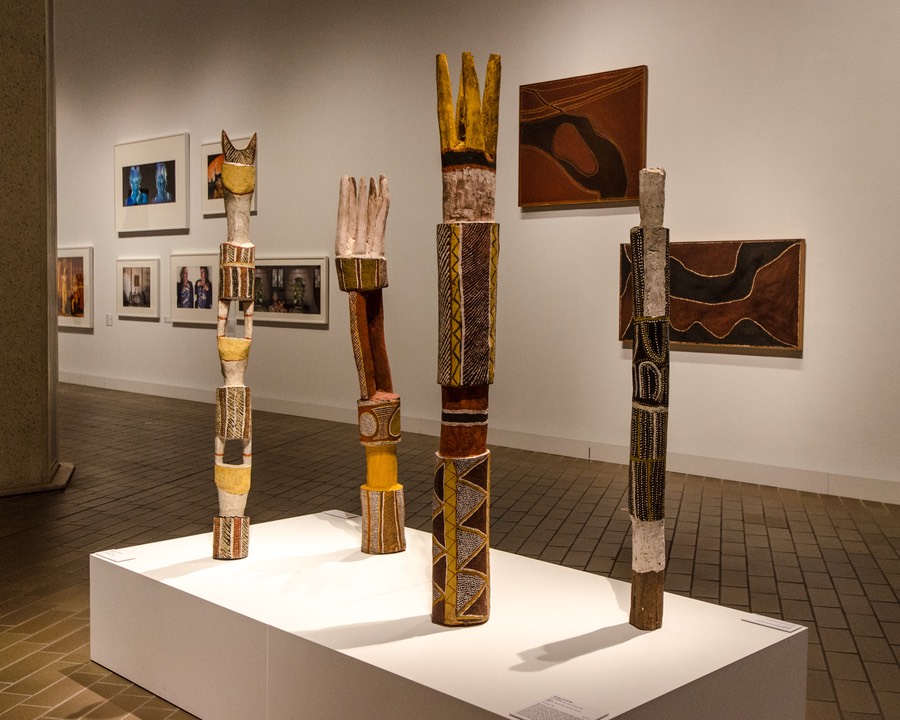
Our time in Canberra also included a very special, very unusual meeting that we expect to long remember. At the National Gallery we met a young woman who was manning the cloak room. Christina Lee was immediately charming and interesting to talk to and was interested in us and our travels. We hung around for a few minutes chatting between her breaking off to help other visitors, and eventually set up a time to meet for coffee the next day at the National Museum, which is adjacent to the University where she is a student. Well, it was a wonderful visit with a new friend. We talked about travel and places we’d been, but also about what Christina is doing. In addition to her studies at university, she is active in raising funds for and awareness of libraries and combating human trafficking in small villages in Nepal. She turns twenty this year and has been involved in these issues since she was fourteen. She’s been to Nepal once already and is planning a return trip later this year with a group of friends from university. Altogether an extraordinary young woman and a real pleasure for us to meet. With Christina’s permission, we’ve included a link to tell you all about Project Nepal.
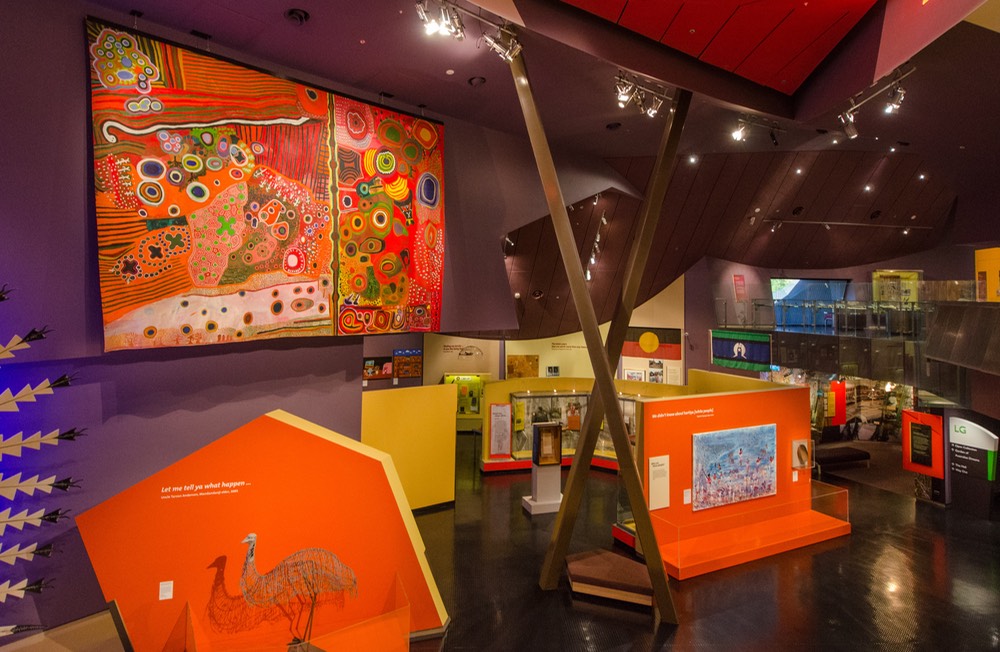
Then, on our last day in Canberra, we visited the National Museum of Australia. In itself, it maybe had the least to amaze us with, as we already knew much about what was offered. But one really interesting thing, which was both positive and negative, was that it was a new building, with really wild architecture that flung the galleries and exhibits in all sorts of directions and was sort of difficult to follow logically. That’s the negative side, but the positive was that it invited you to set aside preconceptions of how materials should be displayed and just view the settings simply as they came along — each one a surprise, some juxtaposing disparate themes that you might otherwise think are very out of place. Hard to explain, and more difficult to enjoy than maybe it should have been (at least for us), but we can applaud innovation. And please don’t let us put you off on making a visit. It probably would have worked better for us had we not visited on our last day, when time was already tight and energy levels flagging.
We finally simply had to leave the capital city; we’d run out of day and didn’t have a place for the night. So we headed out, stopping briefly in the suburb of Belconnen. A tip-off from our good friends in Raleigh, NC had told us that Goodberry’s, the splendid creamery in North Carolina, now had two branches open in the Canberra area, one of them in Belconnen. We’d planned our departure route from the capital to pass by there. We came, we saw, we were conquered yet again. The Goodberry’s ice cream is splendid, and hadn’t lost any of its charm from being half-way round the world. Thanks, John and Beth!!!
Our next focus in NSW took us west to the small town of Temora, which has an aviation museum that we’d learned about at the visitor center in Cowra. This part of NSW is a great area for small towns. One after another they are neat, tidy and healthy looking, with great bakeries, real local stores and shops, and plenty of things going on, including excellent visitor information centers. Temora, like Cowra, has some major WWII history to draw on, and it does it well. It was home to a big pilot training program that operated throughout the war, training something like 2,400 pilots.
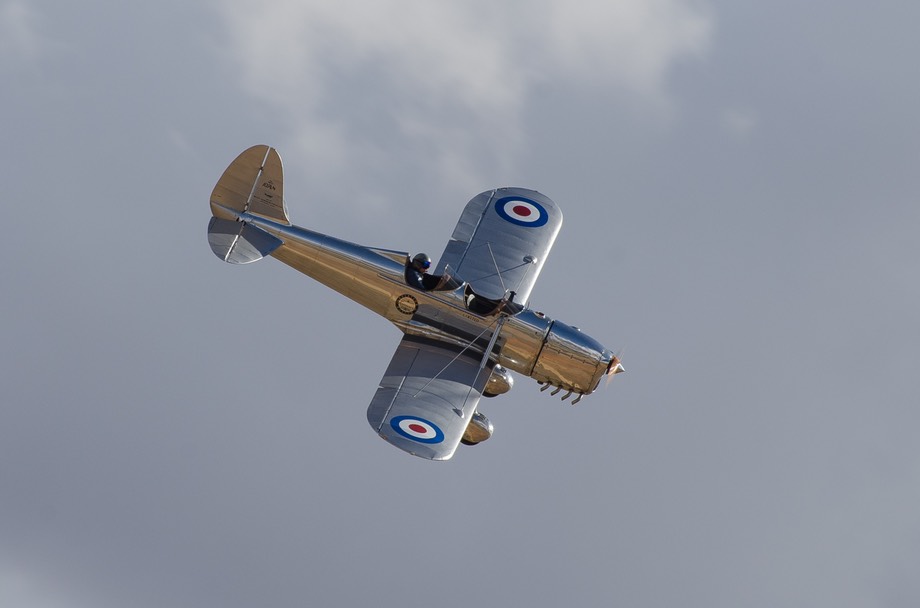
The aerodrome is still there and twenty years ago the Temora Aviation Museum was established. This is the real deal, with a small but excellent collection, full time staff to maintain the aircraft in flying condition, and once a month flying days to welcome the enthusiast — in addition to the museum being open every day. It’s a lovely place and the planes are an impressive group, featuring the only two Spitfires in flying condition in Australia and one of the original group of Tiger Moth biplanes that were used to train pilots at Temora during the war. Temora alternates years with the fantastic Omaka Aviation Heritage Centre in New Zealand as host of the annual War Birds Down Under meet. It happens in Australia this year, but not until October. Motor-Museums.com will provide a photo tour of the aviation museum.
Leaving Temora, we made a quick run down to Melbourne, by way of the lovely old city of Albury. We’d been through before, enjoying good shopping and a nice camper van dealership with repair shop attached. But this time was more special. It’s really fall here in Australia now, and the trees have all taken on a wonderful, beautiful new life. We wandered the streets, with leaves on the ground everywhere, paying special attention this time to the terrific art deco architecture that prevails in the downtown area. No camera at hand, so you’ll just have to take our word for it; extraordinary buildings in excellent shape and with very inventive architecture at every step. It was a lovely day, bright and sunny for the first time in over a week, and a real treat.
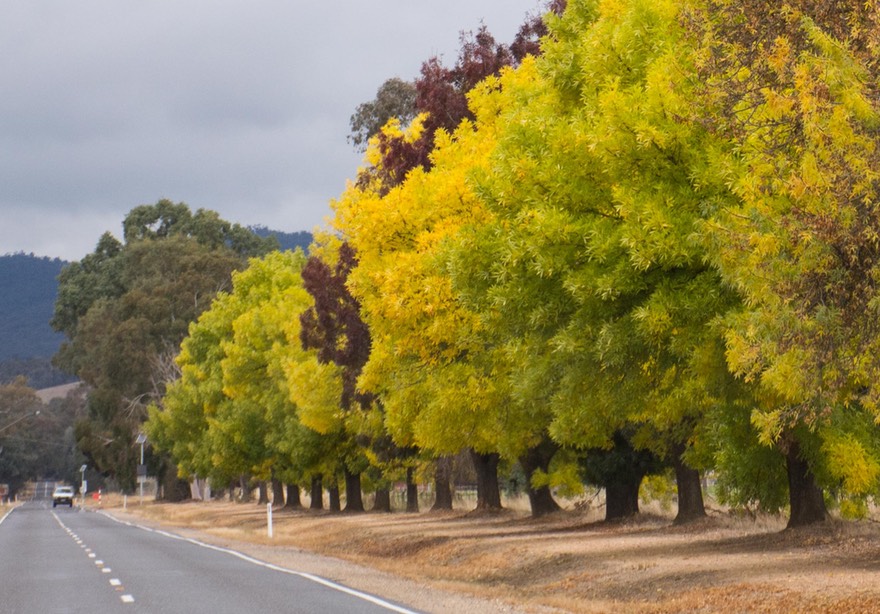
We were heading down toward Melbourne because we finally had a shipping date for the Tiger (YAY!!) and had an appointment to meet with Frank, our shipping agent (the same great guy who’d handled everything for us when we arrived in Melbourne almost a year ago). He needed us to take him our new carnet, which was essential to him in making arrangements and establishing bona fides for the truck. We sat and chatted for a bit, finalizing plans to meet him at the port on the morning of June 4. At that point he will deliver the Tiger into the hands of the port people and then drive us to the airport, as we have organized a flight back to the states that same evening. The Tiger leaves on June 8 for Durban, South Africa (by way of Singapore; don’t ask). Well, go ahead and ask if you like, but we won’t bore everyone with the details here.
Our last few weeks were starting to pull together. We’d been in touch with Annie and Derek, also in the Melbourne area, who’d contacted us on our website, wanting to get together to talk about long-term overland travel. We spent an afternoon and night with them, and had a ball. They are great people who fed us, entertained us, picked our brains, took us to meet other friends (who also fed us — we ate more meat during one 24-hour period than we had over the last entire month — all of it just great), then off to a meeting of the local 4WD group; then fed us again in the morning — all of it filled with giggles, great discussions, and a whole lot of whooping and hollering. Such fun. We are hoping to see them again before we fly away.
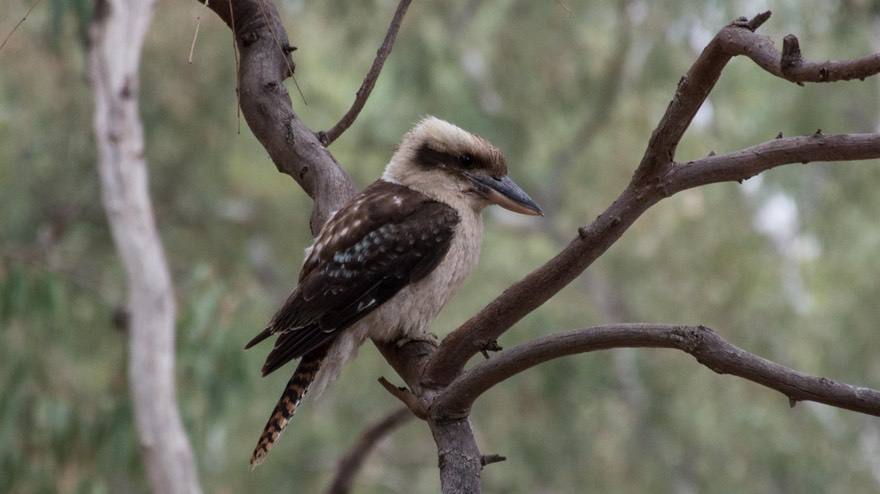
Fleeing Melbourne, we headed back up into NSW. We decided we had time for a second visit to Temora, to attend their monthly flying day on the coming weekend. We made a short detour along the way, to visit the Koala Rescue Sanctuary outside the country town of Narrandera (Narran-dra of course, rhymes with Can-bra). It’s along a pretty creek, and makes a great walk, which I really enjoyed. Plenty of birds, and lovely red river gums — but the koalas managed to stay hidden. Not to worry: it was a great spot and the koalas would simply have been icing on the cake.
On northward, toward Temora. It seems these last few weeks will be spent bouncing back and forth between Victoria and New South Wales. Not so efficient or practical, but very much okay by us. The country is nice, and it’s definitely fall now, closing in on winter. Looks like some snow fell in the mountains last night. Getting close to Good-By Time!!!
We are realizing that there are many things we will miss about Australia and it will indeed be hard to say good-by. We spent last night parked beside the Murray River and remembered where we’d first met the Murray nearly a year ago and how lovely it is, with its wide banks and huge trees and oh so many birds chattering busily.
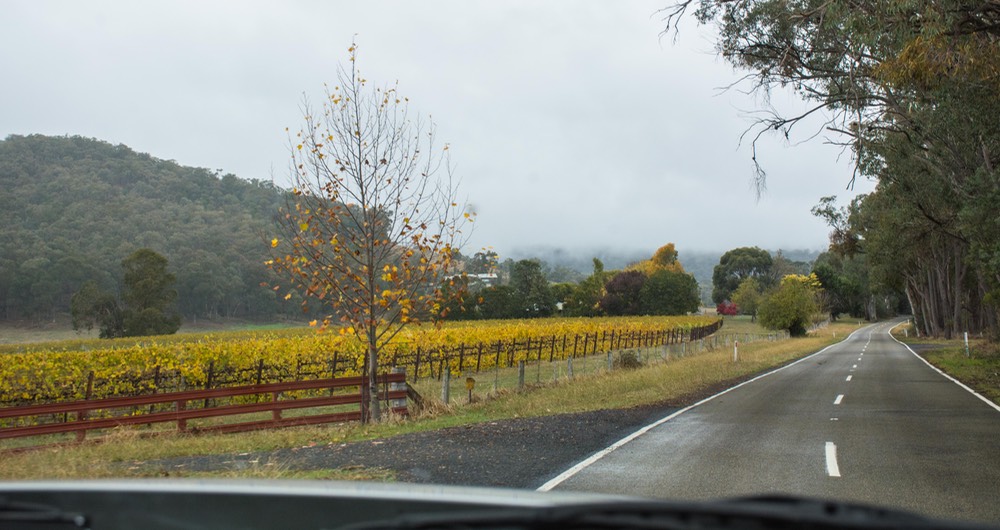
We came across the small town of Ardlethan, complete with a big sign at the entrance proclaiming the hamlet as the home of the Kelpie dogs. Hmmm… Casterton, in southwest Victoria, says the same thing.
Back at Temora, the Aviation Museum flying day was great fun; it is always such a treat to hear old planes running up their engines and to see them up in the sky. Rick madly took tons of pictures of the planes in the air, experimenting with different shutter speeds and things like that. There was food to be had and an excellent talk about the restoration process for one of the planes. Good stuff.
But I bet you’re starting to say “Where’s the licorice and chocolate, huh?” At least it means you haven’t fallen asleep. Well!! The hamlet of Junee is only about 17 kms southwest of Temora. And yes, we visited there each time as we left Temora, stopping to shop, as it were. Another excellent experience.
It’s getting quite chilly now. Down close to freezing at night, and rarely above the mid-50’s during the day. We’ve dug down and found the heavy socks and sweaters we put away when we flew from New Zealand to Australia a year ago. They are filthy with dust from all the back roads we’ve been traveling here, but after a bit of a shaking out they are now helping us feel all cozy and warm.
We have one more stop to make, a revisit to the nice town of Myrtleford, where we are going to have some service work done on the Tiger (remember that rattle?) before putting it on the boat, then it will be back down into the greater Melbourne area where we will stay until the fated day. It takes a while to get the truck ready for shipping onward, and I do hate to arrive in a new country with dirty laundry waiting, so there’s lots to do. So think of us removing the spare tire and finding a place inside the truck to store it (NO, NO, NO! NOT ON THE BED!). Washing and waxing, dusting and wiping and purging tanks, and sorting clothes and… but you don’t want to hear all that.
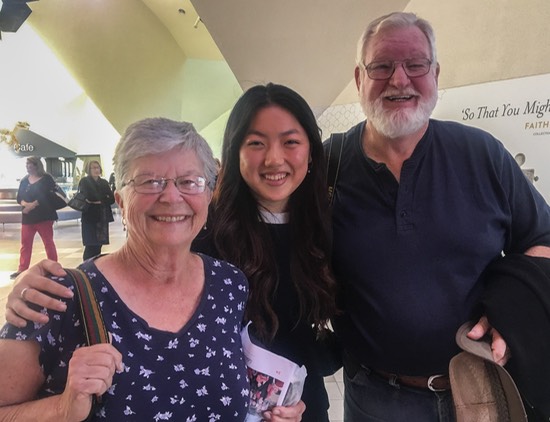
We’ve promised several of you that we will share some final thoughts on our experiences in Australia, and we hope to have that ready to go before too long. We will be finishing it up in between seeing doctors and family and friends back in California. We arrive at LAX the evening of June 4 — that is not a typo, we arrive the same evening we depart. Not a next generation of SST, simply the wonders of the International Date Line, which will allow us to arrive nearly three hours earlier than we depart Melbourne. We expect to be stateside about 5-6 weeks. The ending date is uncertain, due to the vagaries of shipping these days. We have an ETA in South Africa for the Tiger, but… well, we’ll believe it when we see it. Once we know for sure when it will arrive we’ll be flying off to Africa to wave the Tiger ashore and start new adventures at our next NEEP.
In the meantime, adios from Rick and Kathy and the Tiger, muttering about slow boats to China… or wherever.
Here’s our Photo Gallery for Autumn Leaves